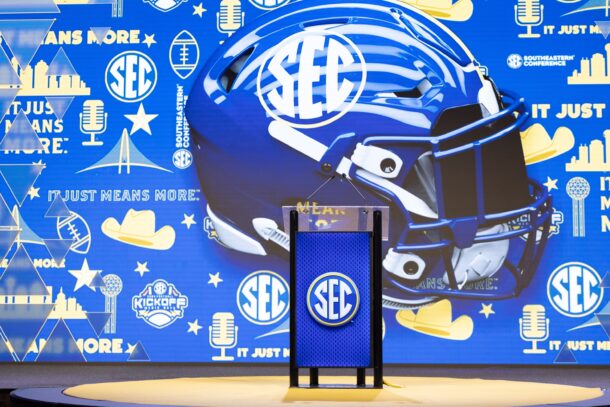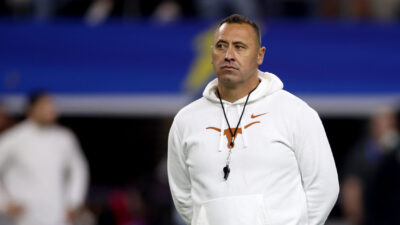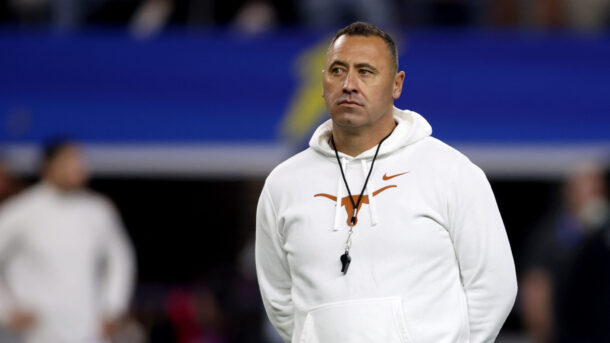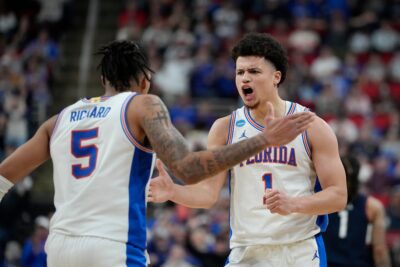Ad Disclosure

1 key matchup for every first-round College Football Playoff game: Picks, predictions
The first round of the College Football Playoff is almost here.
For the first time ever, we’ll have a slate of 4 first-round College Football Playoff games. This story will aim to parse through details from the statistical profiles of these first-round participants — with a prediction and betting pick included for each game.
Here’s 1 key matchup (and prediction) for every first-round College Football Playoff game in 2024:
Indiana at Notre Dame matchup and prediction
Matchup to watch: Indiana’s passing game vs. Notre Dame’s defense
Indiana’s offense has been elite for the vast majority of the 2024 season. The Hoosiers enter this week’s Playoff game against Notre Dame ranked No. 6 nationally in EPA-per-play, according to Game on Paper. They’re also No. 3 nationally in offensive success rate and No. 1 in EPA-per-pass.
In theory, it should be easy to feel good about the Hoosiers’ offense going into a Playoff setting. But the reality is that Indiana’s strength-of-schedule this season was exceptionally weak and its offense certainly had some difficulties when the quality of opponent increased.
Indiana averaged just 2.5 yards per play in its 38-15 loss to Ohio State this season — and that number was significantly inflated by a meaningless last-minute touchdown drive. The Hoosiers finished with 151 total yards on the day. Indiana bookended the day with touchdown drives of 70 and 75 yards. For the 8 drives that began in either the 2nd or 3rd quarters, Indiana managed a grand total of 1.13 yards per play.
When Indiana played Michigan and Washington, things were a little better, but not that much better. IU averaged under 4.4 yards per play in both of those contests as well. The difference was that Indiana’s defense was able to make a big impact, particularly in the Washington game. But the offense still played poorly enough to put IU in danger of losing both of those matchups.
Ohio State, Washington and Michigan were the only defenses Indiana faced that ranked in the top-30 nationally in yards per play allowed this season. Several other Big Ten teams accomplished that feat, including Minnesota, Iowa, Oregon and Penn State, but the Hoosiers avoided them all. So it seems worth noting that Indiana’s offense didn’t have a particularly good game against a great defense all season. Collectively, IU averaged just 3.81 yards per play against that trio of stout defenses.
Enter Notre Dame, who is 6th nationally this season in terms of yards-per-play allowed. The Fighting Irish haven’t faced a gauntlet of opposing offenses in their own right, but they’ve held their own against solid units such as Louisville, Army, Navy and Georgia Tech.
The biggest problem Notre Dame can pose Indiana is up front. The Fighting Irish have a very strong defensive line, and the offensive line is where things fell apart for Indiana in tough matchups this season — particularly against the Buckeyes. If Indiana gets behind the chains frequently, Kurtis Rourke has not had much success in converting 3rd-and-long situations this season. Rourke has a passer efficiency rating of just 143 when throwing the ball on 3rd-and-8 or longer. That ranks 28th nationally in that spot amongst QBs with at least 25 such pass attempts. That may not seem too bad, but consider that Rourke’s overall passer rating is 181.4, which was by far the best mark in the country during the regular season. IU’s offense relies on him being elite, and he can’t be that when the Hoosiers sustain negative plays.
On the other side, no defense in the entire country was better than Notre Dame was on 3rd and 8 or longer. The Fighting Irish posted a pass defense efficiency rating of 63.6 in that spot this season. Opposing offenses gained just 3.3 yards per play in that spot and achieved a first down on only 7 out of 39 passes (18% success rate). Avoiding 3rd-and-long scenarios is paramount to Indiana’s chances against the Fighting Irish.
PICK: Kurtis Rourke under 198.5 passing yards (-114 via FanDuel)
States: MA, NJ, PA, VA, MD, WV, TN, LA, KS, KY, NC, AZ, CO, IA, WY, IL, IN, OH, MI, NY
21+ and present in a state with legal sports gaming. Gambling problem? Call 1-800-Gambler.
SMU at Penn State matchup and prediction
Matchup to watch: Drew Allar vs. SMU’s secondary
Prior to Penn State’s Big Ten Championship Game against Oregon, I wrote about Allar’s struggles in big games. Even in the midst of improved performance overall this season, Allar had still not really put up a good performance against a ranked opponent in his Big Ten career.
That did not change in Penn State’s 45-37 loss to Oregon in the conference title game earlier this month. Allar posted a passer efficiency rating of 115.1 vs. the Ducks and averaged just 5.79 yards per attempt. In 7 career games against AP Top 25 opponents, Allar still doesn’t have any performances with a passer efficiency rating above 145 — and 6 of them are below 125.
Here’s some context on how Allar’s performance vs. ranked and unranked opposition compares to the average power-conference QB over the past 2 seasons:
| Passer rating vs. unranked teams | Passer rating vs. ranked teams | |
| All power-conference QBs | 144.0 | 126.5 |
| Drew Allar | 163.5 | 113.4 |
In general, Allar has been significantly better than the average QB vs. unranked teams and meaningfully worse than the average QB vs. ranked teams.
SMU’s defense is certainly formidable enough to make things difficult on Allar and the Nittany Lions. The Mustangs allowed just 4.65 yards per play this season, which ranks 10th nationally entering the first round of the Playoff. Only 3 opponents managed to post an above-average passer efficiency rating against SMU this season: TCU, Louisville and Clemson in the ACC title game.
Penn State does run the ball about 56% of the time (and even more if it’s protecting a lead), so it’s worth noting that SMU has the nation’s No. 3-ranked rushing defense in the country entering this game. The Mustangs have only allowed 2.74 yards per rush this season. Only 1 team on SMU’s schedule all season managed to clear 4 yards per attempt (Boston College).
If Penn State is going to win this game, something will have to give. Either the Nittany Lions are going to have to run the ball better than any team has on SMU all season, or Allar will have to have his first-ever great game against a ranked opponent. Ultimately, I think Penn State has a big enough talent edge overall to win this game, but I’m going to fade Allar’s passing yardage total in spots like this until he proves he can be efficient in a big-time game.
PICK: Drew Allar under passing yardage under 229.5 (-115 via bet365)
Clemson at Texas matchup and prediction
Matchup to watch: Clemson’s deep passing game vs. Texas’s secondary
Clemson’s offense has been a bit of a roller coaster this season. The Tigers started off by getting trounced by Georgia in the season-opener way back in Week 1 before blasting a seemingly-never-ending conveyor belt of mediocre teams for 2 straight months.
At some point late in the season, Clemson’s running game began to evaporate. Phil Mafah averaged just 4.13 yards per rush during the month of November and then followed that up with 13-carry, 28-yard performance against SMU in the ACC Championship Game. It’s not all on Mafah — Clemson’s offensive line has battled injuries in recent weeks. But regardless of who gets the blame, there’s an unpleasant reality Clemson backers should realize before the Tigers take on Texas: Clemson hasn’t been able to run the ball consistently for weeks.
And while Cade Klubnik has certainly been improved this season, a lot of his increased production is relatively one-dimensional. He’s turned into a great deep-ball thrower, which has allowed him to increase his yards-per-attempt from 6.3 in 2023 to 7.5 in 2024.
Of course, that 7.5 number isn’t anything to write home about. Even in a season that’s lacking hyper-efficient passers, that still only ranks 54th nationally amongst qualified quarterbacks in 2024. What’s unusual about Klubnik is that he actually ranks pretty highly in terms of big plays — he’s tied for 15th nationally in pass completions of 25+ yards this season with 30.
Usually when we see inefficiency issues with quarterbacks, it’s because they’re not comfortable pushing the ball down the field. That hasn’t been Klubnik’s problem. Since 2015, there have only been 25 quarterbacks to complete at least 30 passes of 25+ yards and have a yards per attempt under 7.5 in a single season. There are a couple notable names on the list for what they would go on to accomplish in the NFL (Jalen Hurts in 2016 and Jordan Love in 2019), but for the most part, it’s a list of quarterbacks with limited passing skillsets.
To his credit, Klubnik has the best passer efficiency rating (148.6) of any of those 25 quarterbacks who meet that criteria. But being so reliant on the deep ball to make progress can become a problem pretty quickly — especially when running the ball isn’t a great option either. Take the ACC Championship Game for example. In that game, Clemson’s downfield passing game accounted for 158 yards on just 6 plays. The problem was that Clemson totaled just 168 yards on its other 67 plays. That’s a grand total of 2.5 yards per play outside of the deep passing game — and the biggest reason why SMU nearly came back from 17 points down against the Tigers.
Now here’s where it gets tricky for Clemson in this matchup vs. the Longhorns: Texas has one of the best secondaries in the entire country. The Longhorns are 2nd in pass defense efficiency this season behind only Notre Dame with a rating of 95.1. By passer rating (120.1), Kentucky had the best performance through the air against the Longhorns than any other team this season.
Specifically, Texas has done a great job of limiting deep passes this season. The Longhorns only allowed 10 completions of 25+ yards or more all season. That’s just 2.48% of all pass attempts they faced this season. Amongst all FBS teams since the beginning of the 2019 season, only 2021 Washington (2.08%) and 2020 Northwestern (2.28%) posted a better figure than this Texas team has in that category this season.
So if Clemson can’t run the ball and its advantage in the passing game is clashing with a Texas defense that is elite at preventing deep passes, then how exactly are the Tigers going to move the ball?
PICK: Clemson team total under 20.5 (-135 via BetMGM)
Tennessee at Ohio State matchup and prediction
Matchup to watch: Tennessee’s tempo vs. Ohio State’s defense
It’s been well-documented that tempo is way down in college football compared to its peak in the early 2010s when it seemed like nearly every successful offense was influenced by Chip Kelly or Mike Leach. Most teams have slowed down considerably over the last decade or so, particularly in 2024 with the introduction of player-to-coach communication.
But there’s still one elite team that likes to play with a little pep in their step: Tennessee. On average, they’re firing off a new play every 24.3 seconds (excluding OT) according to Radar360. That would have been considered mediocre a decade ago, but it’s good enough to land the Vols in the top-15 in tempo this season.
That certainly presents an interesting stylistic matchup with the Ohio State defense. Oregon was the highest-tempo team Ohio State faced all season in the Big Ten, and the Ducks ran a play every 27.1 seconds — good enough for 63rd nationally. They did play a couple of nonconference games vs. faster teams in Akron and Marshall, but it’s tough to take much from those matchups considering the talent mismatch at play. The Ducks were the only Big Ten team Ohio State faced this season who ranked in the top 90 in tempo.
The really scary thing is that Tennessee could go even faster if it needs or wants to. It maintained a pace of roughly 24 seconds per play despite having a rushing rate north of 58%. To get an idea of how rare that is, here’s this: Over a sample of more than 650 power-conference seasons since 2015, only 14 teams have managed to have a rushing rate above 58% and operated at a faster pace than Tennessee has in 2024.
Does that inherently mean that Ohio State is going to struggle with Tennessee’s offense? Not necessarily. Pace and efficiency don’t necessarily go hand-in-hand, and Ohio State does have a very stout defense. But it’s certainly worth acknowledging that Ohio State didn’t see anything in the Big Ten this season — apart from perhaps Oregon — to prepare it for the pace it will see from the Vols on Saturday night.
Tennessee’s pace is something Ohio State defensive coordinator Jim Knowles addressed during his media availability on Tuesday. Knowles downplayed the impact it would have on his defense, stating that his scheme is “built for tempo” because it was designed when he was Duke’s defensive coordinator during the height of the up-tempo movement in college football.
While some may roll their eyes at the idea that anything from Knowles’ Duke tenure could be applicable to Saturday’s Playoff game from the Vols, the numbers do back him up (albeit in a very small sample). Since Knowles arrived in Columbus in 2022, Ohio State’s defense has faced 5 teams that have run plays at a more-frequent rate than 24.5 seconds per play. The Buckeyes allowed an average of 3.5 yards per play in those contests and won all 5 games by an average margin north of 17 points.
I do think tempo is going to play some sort of a role in this matchup, but ultimately I think Ohio State’s talent on defense will get enough stops.
PICK: Ohio State vs. Tennessee total under 46.5 (-110 via ESPN BET)
Want to bet on Tennessee’s College Football Playoff game? Use the SDS guide to Tennessee sports betting apps and get in on the action today!
Spenser is a news editor for Saturday Down South and covers college football across all Saturday Football brands.




